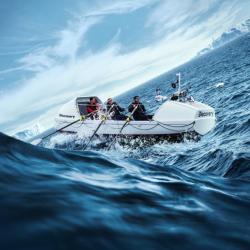 Six men have become the first to row unassisted across Drake’s passage, between South America and Antarctica. The effort was led by adventurer Colin O’Brady. In just under 13 days, they rowed more than 700 miles in a 29-foot boat named Ohana.
Six men have become the first to row unassisted across Drake’s passage, between South America and Antarctica. The effort was led by adventurer Colin O’Brady. In just under 13 days, they rowed more than 700 miles in a 29-foot boat named Ohana.
The other men on the expedition were: Fiann Paul of Reykjavik, Iceland; Cameron Bellamy of Cape Town, South Africa; Andrew Towne of Grand Forks, North Dakota; and John Petersen of Oakland, California.
Paul, Douglas-Hamilton and Bellamy are record-breaking ocean rowers, Towne is a championship rower and has climbed the tallest mountain on every continent, and Petersen was a championship college rower.
O’Brady is an American professional endurance athlete and a former professional triathlete. On December 26, 2018, he became the first person to cross the landmass of Antarctica, solo and unsupported.
The project was supported by the Discovery Channel which documented the voyage in real-time while following Ohana in a support vessel.
Thanks to Irwin Bryan for contributing to this post.

This trip was accomplished in 1987 by adventurer Ned Gillette in the “Sea Tomato” (it was painted red), supported by National Geographic and other Corporate sponsors. There were three other crew members with Ned in a 28′ vessel with sliding seats fore and aft and a central cabin. The boat had a sailing rig which I designed at MacDougalls Boat Yard on Cape Cod. We spent the winter of 1985 – 86 in Punta Arenas, Chile and the western archipelago rowing and waiting for the ice along the Antarctic Peninsular to breakup , which it never did. The next year, 1987, with favorable ice conditions they sailed west on a nor-easter for two days before stowing the rig and rowing south, catching the westerly winds and currant.
The trip started about 100 miles north of Cape Horn and they ended up on the Antarctic Peninsular approximately 5-6 miles from the planed landfall seven and a half days later. There were no support vessels in attendance and none of the crew were professional rowers.
The vessel and crew were picked up on the Peninsular by the Argentine Navy as planed and the vessel is now used for rowing training and owned by the Argentine Navy in Punta Arenas, Chile
We took 13 days to round the Horn east to west in EUROPA in 2015 that was tough enough one has to admire both these groups achievements